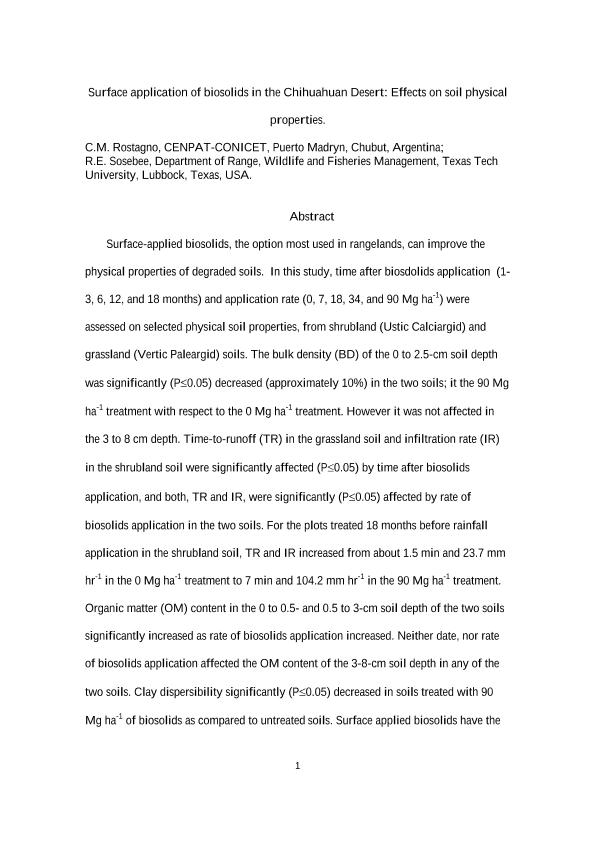Artículo
Surface application of biosolids in the Chihuahuan Desert: Effects on soil physical properties
Fecha de publicación:
12/2001
Editorial:
Taylor & Francis
Revista:
Arid Soil Research And Rehabilitation
ISSN:
0890-3069
Idioma:
Inglés
Tipo de recurso:
Artículo publicado
Clasificación temática:
Resumen
Biosolids (anaerobically digested sewage sludge) have been applied to agricultural lands for many years and more recently to rangelands as a soil amendment to add plant macro and micronutrients and organic matter to the soil. Surface-applied biosolids, the option most often used on rangelands, can increase the concentration of macronutrients and trace elements in the topsoil. In this study, the effects of biosolids application date (January and July of 1995 and 1996) and application rate (0, 7, 18, 34, and 90 Mg ha-1) on selected hydrological and physical soil properties, solid (sediment and biosolids) removal, and selected soil chemical properties from shrubland (Ustic Calciargid soil) and grassland (Vertic Paleargid soil) soils were assessed. Between July and October, 1996 simulated rainfall was applied to 0.50 m2 plots with a single-nozzle rainfall simulator for 30 min at a rate of 160 mm hr-1. All of the runoff water and sediment were collected. Infiltration rate increased in the two soils as biosolids application rate increased. In the shrubland soil where the biosolids rate effect was more marked, the infiltration rate in Jan 95 increased from 23.7 to 104.2 mm hr-1 in the 0 and 90 Mg ha-1, respectively; in Jul 96, infiltration rate increased from 34.0 to 66.6 mm hr-1, respectively. Date of biosolids application significantly (P£0.05) affected the infiltration rate only at the highest biosolids application rates (34 and 90 Mg ha-1) on the shrubland soil. The bulk density of the 0 to 2.5-cm soil depth was significantly (P£0.05) affected in the shrubland soil. In this soil, bulk density in the 90 Mg ha-1 treatment decreased approximately 10% respect to the 0 Mg ha-1 treatment. In the 0 to 0.5-, and 0.5 to 3-cm soil depths of the shrubland and grassland soils, organic matter content significantly (P£0.05) increased and clay dispersibility significantly (P£0.05) decreased as rate of biosolids application increased. In the two soils, sediment production decreased as rate of biosolids application increased. In the Jul 96 treatment and for the shrubland soil, sediment production decreased from 134 to 2.40 g m-2 in the 0 and 90 Mg ha-1 treatments, respectively. In the grassland soil and for the same treatment date, sediment production decreased from 157 to 6.70 g m-2, in the 0 and 90 Mg ha-1 treatment, respectively. The highest amount of biosolids losses in the runoff water were recorded from plots treated in Jan 95 with 18 Mg ha-1, 34 and 36 g m-2 from the shrubland and grassland soil, respectively. The EC, pH, and total Kjeldhal N of the 0 to 0.5- and 0.5 to 3-cm soil depths were significantly (P£0.05) affected by rate of biosolids application in the two soils. The EC of the upper soil layer significantly (P£0.05) increased in the two soils as time of biosolids postapplication decreased. Cu concentration in the 0 to 0.5- and 0.5 to 3-cm soil layers and for most application dates increased significantly (P£0.05) in the plots receiving biosolids with respect to the controls. Zn concentration significantly (P£0.05) increased in the 0.5 to 3-cm soil layer of the shrubland soil treated with biosolids in Jan 95 and Jul 95. For this soil, the enrichment of total N in the eroded sediments of the control plots was 40%, and increased to 1600% in the plots treated with 18 Mg ha-1 in Jan 95. In the same treatment, the enrichment of Cu and Zn in the eroded sediments increased from 96% and 160% in the control plots, to 1660% and 1460% in the treated plots, respectively. Surface-applied biosolids increased the infiltration rate and decrease the sediment production in the two soils, although the effects were more important in the shrubland than in the grassland soil. Although surface-applied, biosolids have the potential to increase the organic matter, TKN, and Cu and Zn in the upper 3-cm of soil. Surface-applied biosolids can be transported by runoff water what may produce a long-term impact in the receiving waters.
Palabras clave:
Surface-applied biosolids
,
biosdolids application
Archivos asociados
Licencia
Identificadores
Colecciones
Articulos(CCT-CENPAT)
Articulos de CTRO.CIENTIFICO TECNOL.CONICET - CENPAT
Articulos de CTRO.CIENTIFICO TECNOL.CONICET - CENPAT
Citación
Rostagno, Cesar Mario; Soseebe, R. B.; Surface application of biosolids in the Chihuahuan Desert: Effects on soil physical properties; Taylor & Francis; Arid Soil Research And Rehabilitation; 15; 12-2001; 233-244
Compartir
Altmétricas




